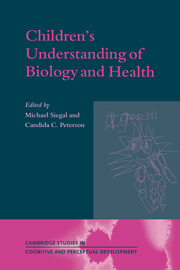Book contents
- Frontmatter
- Contents
- List of contributors
- Preface
- 1 Becoming mindful of biology and health: an introduction
- Part I Development of biological understanding
- 2 Children's understanding of mind–body relationships
- 3 How a naive theory of biology is acquired
- 4 Constructing a coherent theory: children's biological understanding of life and death
- Part II Health issues
- Part III Applications
- Appendix: Hypothetical dilemma vignettes
- Author index
- Subject index
4 - Constructing a coherent theory: children's biological understanding of life and death
Published online by Cambridge University Press: 06 July 2010
- Frontmatter
- Contents
- List of contributors
- Preface
- 1 Becoming mindful of biology and health: an introduction
- Part I Development of biological understanding
- 2 Children's understanding of mind–body relationships
- 3 How a naive theory of biology is acquired
- 4 Constructing a coherent theory: children's biological understanding of life and death
- Part II Health issues
- Part III Applications
- Appendix: Hypothetical dilemma vignettes
- Author index
- Subject index
Summary
Sophie stood on the gravel path, thinking. She tried to think extra hard about being alive so as to forget that she would not be alive forever. But it was impossible. As soon as she concentrated on being alive now, the thought of dying also came into her mind. The same thing happened the other way around: only by conjuring up an intense feeling of one day being dead could she appreciate how terribly good it was to be alive. It was like two sides of a coin that she kept turning over and over. And the bigger and clearer one side of the coin became, the bigger and clearer the other side became too.
(Jostein Gaarder, Sophie's World, 1995, p. 6)The concept of death is emotionally charged and cognitively challenging. Understanding that all people die, that death is the inevitable end of the life cycle of each living individual, is fundamental to our understanding of ourselves as human beings. Conceptualizing and accepting death has consequences for how we live our lives as well as for how we manage our health. For these reasons, twentieth-century psychologists of many different theoretical persuasions – Freudians, Piagetians, educators, health psychologists – have described young children's grappling with the concept of death. These studies have documented in great detail the ways in which preschool children conceive of death differently from their elders, and the steps they take in approximating adult understanding.
- Type
- Chapter
- Information
- Children's Understanding of Biology and Health , pp. 71 - 96Publisher: Cambridge University PressPrint publication year: 1999
- 58
- Cited by



